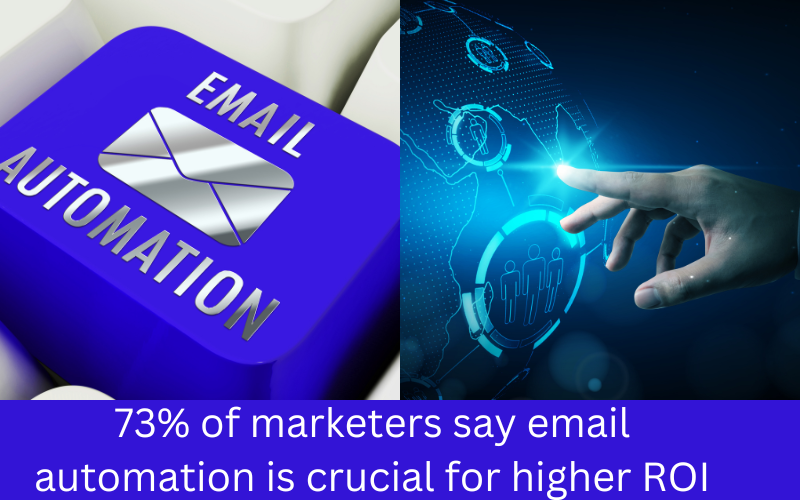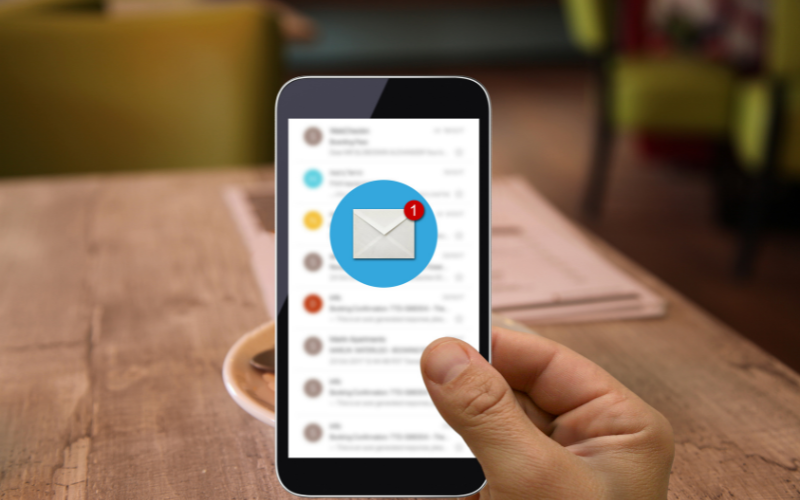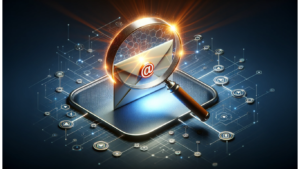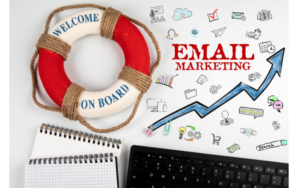Are you ready to catapult your email marketing strategy into the future? In a digital world where change is the only constant, staying ahead of the curve is imperative.
This comprehensive guide unpacks the key email marketing trends in 2023 that you can’t afford to ignore. From automation and personalization to mobile optimization and the transformative powers of AI, we delve into what it takes to succeed in the fast-paced world of email marketing.
Read on to future-proof your strategy and set your brand up for success.
Table of Contents
Automation in Email Marketing: A Cornerstone in Email Marketing Trends for 2023
Introduction
Email marketing remains one of the most effective channels for reaching your audience, but its landscape is ever-evolving. One of the most significant email marketing trends in 2023 is the increasing reliance on automation. But why is it so pivotal, and how can businesses take full advantage of it?
The Importance of Automation in Email Marketing
Automation in email marketing is not just a trend; it’s becoming a necessity. Automated email campaigns allow businesses to send timely, relevant messages to their audience without the need for manual intervention. This not only saves time but also significantly improves ROI.
Statistics to Consider:
- According to a recent study, 73% of marketers consider email marketing automation to be crucial for achieving a higher ROI.

Email Marketing Metrics
Email marketing metrics are the data points that you use to measure the success of your email marketing campaigns. These metrics can help you to track your progress, identify areas for improvement, and make better decisions about your future campaigns.
Some of the most important email marketing metrics include:
- Open rate: This is the percentage of emails that are opened by recipients.
- Click-through rate (CTR): This is the percentage of emails that are opened and then clicked on a link.
- Conversion rate: This is the percentage of people who take a desired action after clicking on a link in your email, such as making a purchase or signing up for a free trial.
- Return on investment (ROI): This is the amount of money that you earn from your email marketing campaigns, minus the amount of money that you spend on them.
Average Open Rates
The average open rate for email marketing campaigns varies depending on the industry and the type of email. However, a good open rate for most businesses is between 20% and 30%.
Average Click-Through Rates
The average click-through rate for email marketing campaigns is also varies depending on the industry and the type of email. However, a good click-through rate for most businesses is between 2% and 5%.
Average ROI
The average ROI for email marketing campaigns is around 122%. This means that for every $1 that you spend on email marketing, you can expect to earn $1.22 in return.

How to Improve Your Email Marketing Metrics
There are a number of things you can do to improve your email marketing metrics. Here are a few tips:
- Segment your list: Segment your email list so that you can send targeted emails to different groups of people. This will help you to increase your open rates and click-through rates.
- Personalize your emails: Personalize your emails by using the recipient’s name and other personal information. This will help to increase engagement and make your emails more relevant.
- Use clear and concise language: Make sure your emails are easy to read and understand. Avoid using jargon or technical language.
- Use strong calls to action: Tell your subscribers what you want them to do, such as click a link or make a purchase.
- Track your results: Track your results so that you can see what’s working and what’s not. This will help you to improve your campaigns over time.
By following these tips, you can improve your email marketing metrics and get more results from your campaigns.
Key Features of Automated Email Campaigns
- Drip Campaigns: These are automated sets of emails that are sent out based on specific timelines or user actions. For example, a welcome series can be set to go out as soon as a user signs up for your mailing list.
- Behavioral Triggers: These are actions that the user takes, like visiting a particular page on your website, which trigger an automatic email response. For example, if a user abandons their shopping cart, an automated email can be sent to encourage them to complete their purchase.
- Segmentation: Automation allows for sophisticated segmentation based on user behavior, location, or any other parameter, making the email content highly personalized and relevant.

Real-world Applications
Businesses in various sectors are harnessing the power of automation in email marketing:
- Retailers are using automation to send personalized product recommendations.
- SaaS companies are utilizing drip campaigns to nurture leads and turn them into paying customers.
Conclusion and Call to Action
Automation is not just one of the email marketing trends to look out for; it’s a cornerstone for any effective email marketing strategy. If you haven’t already incorporated automation into your email marketing, now is the time to do so.
Call to Action: Are you ready to step up your email marketing game? Dive into automation today to stay ahead of the curve.
Strategic Question
- Have you explored various automation tools to find the one that best aligns with your email marketing objectives?
This section aims to provide a comprehensive yet succinct overview of why automation in email marketing is one of the key trends in 2023. It offers actionable insights and statistics that reinforce its importance, making it a valuable resource for anyone looking to enhance their email marketing efforts.
The Rise of Personalization: A Pivotal Shift in Email Marketing Trends
The days of “one-size-fits-all” email marketing are long gone. In 2023, personalization stands as one of the most compelling email marketing trends. But what exactly is email personalization, and why is it more important than ever?
Why Personalization Matters in Email Marketing
Personalization goes beyond just addressing the recipient by their first name. It involves tailoring the email content to individual preferences, behaviors, and interactions with your brand. This hyper-targeted approach leads to more engaged customers and ultimately, higher conversions.
Statistics to Consider:
- A report shows that personalized email campaigns yield 29% higher email open rates and 41% higher click-through rates than generic emails.
Key Features of Personalized Email Campaigns
- Dynamic Content: This allows you to display different content to different recipients based on their behavior or segmentation data. For instance, you can show different product recommendations based on a user’s past purchases.
- Segmentation: Divide your email list into smaller segments based on specific criteria like demographics, purchase history, or engagement level. This enables you to send more relevant emails to each segment.
- Behavioral Triggers: Similar to automation, but more focused on personal user actions. For instance, sending a personalized email when a user abandons a shopping cart, based on the items they left behind.

Add subscriber-specific content to your emails
Real-world Applications
Companies across different industries are embracing personalization:
- E-commerce sites offer personalized product recommendations in their emails.
- Media companies curate content based on the user’s reading history.
Conclusion and Call to Action
Personalization is not merely a buzzword in the list of email marketing trends for 2023; it’s a necessity for any brand that wants to remain relevant and competitive.
Call to Action: Take your email marketing to the next level by embracing personalization. It’s not just a trend; it’s the future.
Strategic Question
- What steps are you taking to implement personalized elements into your email marketing campaigns?
By focusing on personalization, you can significantly enhance user engagement and conversion rates.
Mobile-Optimized Emails: An Unavoidable Component in Email Marketing Trends
The smartphone has become an extension of ourselves, and this shift has major implications for email marketing. Mobile-optimized emails are not just a trend; they’re a requirement. As part of the pivotal email marketing trends for 2023, let’s explore why mobile optimization is indispensable and how to get it right.
The Necessity of Mobile-Optimized Emails
The rise in mobile usage has changed how consumers interact with emails. Sending emails that are not optimized for mobile devices can lead to poor user experiences and missed opportunities for conversion.
Statistics to Consider:
- A staggering 62% of email opens occur on mobile devices, according to recent data.
Key Features of Mobile-Optimized Emails
- Responsive Design: Emails should automatically adapt to the screen size on which they are viewed. This ensures that text, images, and buttons are easily readable and clickable.
- Concise Content: Mobile screens are smaller, which means less room for text and images. Be concise yet compelling in your message.
- CTA Placement: The call-to-action (CTA) buttons should be easy to find and click on a mobile screen. Opt for buttons rather than text links for better visibility.

Real-world Applications
Brands that are ahead of the curve in mobile optimization:
- Travel agencies send mobile-optimized booking confirmations.
- Online retailers use responsive design to showcase their products effectively in emails.
Conclusion and Call to Action
Mobile-optimization is non-negotiable in the current digital landscape. If your emails are not optimized for mobile, you’re already behind.
Call to Action: Don’t miss out on the opportunities that mobile optimization provides. Make it an integral part of your email marketing strategy today.
Strategic Question
- What measures are you currently taking to ensure that your emails are optimized for mobile viewing?
Mobile-optimized emails are more than just a component of email marketing trends for 2023; they are a fundamental necessity for any brand aiming for effectiveness in their email marketing campaigns.
AI and Machine Learning: The Game-Changers in Email Marketing Trends
Artificial Intelligence (AI) and Machine Learning are no longer the stuff of science fiction; they are real and increasingly integrated into our daily lives. In the realm of email marketing trends, AI and Machine Learning stand out as transformative forces. Let’s delve into how these technologies are revolutionizing email marketing.

The Impact of AI and Machine Learning on Email Marketing
AI and Machine Learning offer a plethora of opportunities to make email marketing more efficient and effective. From predicting the best times to send emails to advanced segmentation, these technologies provide a competitive edge.
Statistics to Consider:
- AI-powered algorithms can improve email open rates by up to 15% by predicting optimal sending times.
Key Features of AI-Driven Email Marketing
- Predictive Analytics: AI can analyze past user behavior to predict future actions, such as the likelihood of opening an email or making a purchase.
- Natural Language Processing (NLP): Use AI to analyze text data from customer feedback or reviews to tailor your email content more effectively.
- Dynamic Content Optimization: Machine learning algorithms can automatically test and optimize different types of email content to see what performs best, in real-time.
Case Study: Leveraging AI and Machine Learning to Boost Email Marketing ROI
Quick Summary:
A leading e-commerce company used AI and Machine Learning to optimize its email marketing. The result? A 35% rise in ROI in just six months. Key strategies included personalization, smarter audience segmentation, timing optimization, and customer sentiment analysis.
The Challenge
Email marketing is crucial but tough. Companies often struggle with low engagement rates, impersonal content, and bad timing.
The Solution
Personalization with AI
AI analyzed customer data like past purchases and email interactions. This led to more personalized emails and a 15% higher click-through rate (CTR).
Smart Segmentation with ML
Machine Learning sorted customers into focused groups. This reduced irrelevant emails and lowered the bounce rate by 20%.
Timing with Predictive Analytics
AI identified the best times to send emails, improving the open rate by 10%.
Customer Feedback with Sentiment Analysis
Machine Learning algorithms checked customer reviews to make emails more customer-friendly.
The Results
- ROI Boost: ROI went up by 35% in six months.
- Cost Savings: Automation cut marketing costs by 12%.
- Better Engagement: CTR and open rates improved, while bounce rates dropped.
Takeaway and Next Steps
- Invest in AI and ML: The benefits outweigh the costs.
- Team Up with Data Experts: They can help you use these technologies effectively.
- Keep Algorithms Updated: Customer behavior changes, and your strategies should too.
References
- Forrester Research, “How AI Will Transform Marketing”
- Gartner, “Predicts 2021: Marketers, Invest in Predictive Analytics
Real-world Applications
Several industries are benefiting from the application of AI in their email marketing strategies:
- Financial Services use AI to send personalized investment advice.
- Healthcare providers leverage machine learning to send preventive care information based on patient history.
Conclusion and Call to Action
AI and Machine Learning are not just emerging trends in email marketing; they are set to redefine how businesses interact with customers through emails.
Call to Action: If you’re not leveraging AI in your email marketing strategy, you’re missing out on a wealth of opportunities to engage your audience more effectively.
Strategic Question
- How are you planning to integrate AI and Machine Learning into your existing email marketing strategies?
AI and Machine Learning are transformative technologies that are shaping email marketing trends in 2023. Understanding and adopting these technologies can significantly enhance your email marketing effectiveness.
Conclusion: Future-Proof Your Email Marketing Strategy with Key Trends from 2023
Summing Up the Trends
As we move closer to 2024, staying ahead in the ever-evolving landscape of email marketing is non-negotiable. From the automation of email campaigns and the rise of personalization to the necessity of mobile optimization and the transformative power of AI and Machine Learning, understanding these email marketing trends is crucial for any brand’s success. Additionally, incorporating elements like embedded tweets, expert quotes, and unique data points can make your article a valuable, link-worthy resource.
Why This Matters
Ignoring these trends isn’t just a missed opportunity; it’s a direct route to becoming obsolete in a digital world that waits for no one. Implementing these trends into your email marketing strategy is not just about staying current; it’s about future-proofing your business.
Call to Action
Are you prepared for the future of email marketing? Now is the time to reassess your email marketing strategies and integrate these key trends for 2024. Don’t just follow the trends—be a trendsetter.
Final Strategic Questions
- Which of these email marketing trends are you currently leveraging?
- What actionable steps are you taking to incorporate these trends into your 2024 email marketing strategy?
By staying ahead of these email marketing trends for 2023, you not only set your brand up for success but also make it more resilient to future changes in the digital marketing landscape. Thank you for reading, and here’s to a successful 2024 in email marketing!






Pingback: Email Marketing for Beginners Explained 2023 - Email Marketing Savvy
Pingback: Unlocking Success: 10 Advanced Email Marketing Strategies Explored - Email Marketing Savvy